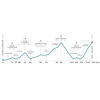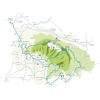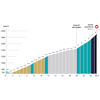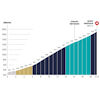The race sets off from Vaison-la-Romaine, a place northwest of the Mont Ventoux. The fastest route to the summit is 30 kilometres long, but instead the riders circle around the Bald Mountain.
Shortly after the start the riders enter the Col de la Madeleine, which is a gentle warm-up climb of 5.6 kilometres à 2.2%. The route moves through Bédoin and continues onto the Col de Gabelle. This is a 10 kilometres climb with an average gradient of 4.2%. After the descent and a false flat of approximately 20 kilometres the first haul up the Mont Ventoux begins in Sault.
Perched on a rocky outcrop and amidst fields of lavender, the fortified village is the start of the sweetest route up the Beast of the Provence: 24.3 kilometres at 5%.
The riders fly down the Ventoux towards Malaucène, which will be the finale of stage 11 on the upcoming Tour de France. Not in the Mont Ventoux Dénivelé Challenge though. The race moves through Malaucène and re-enters the first part of the route. So the Col de la Madeleine reappears and 7 kilometres after the summit the riders reach Bédoin for the second time.
This is where Mont Ventoux begins for real. On this side the ascent is 21 kilometres long and the average gradient sits at 8.7%. The first section through the woods is extremely tough – 3 kilometres at 10% – before it ‘levels out’ to 7.5% in the ensuing 7 kilometres. After Chalet Reynard the scenery changes to a lunar landscape without any vegetation, as if climbing the moon. This section is roughly 6 kilometres long and climbs at almost 8%. The last 1.5 kilometres go up at almost 10%.
The 1st edition of the Mont Ventoux Dénivelé Challenge was won by Jesús Herrada. The Spaniard dropped Romain Bardet in the last 300 metres, while Aleksandr Vlasov took the win last year after distancing Guillaume Martin with 3 kilometres remaining.
Another interesting read: results and start list 2022 Mont Ventoux Dénivelé Challenge.
Mont Ventoux Dénivelé Challenge 2021: route, profiles
Click on the images to zoom



